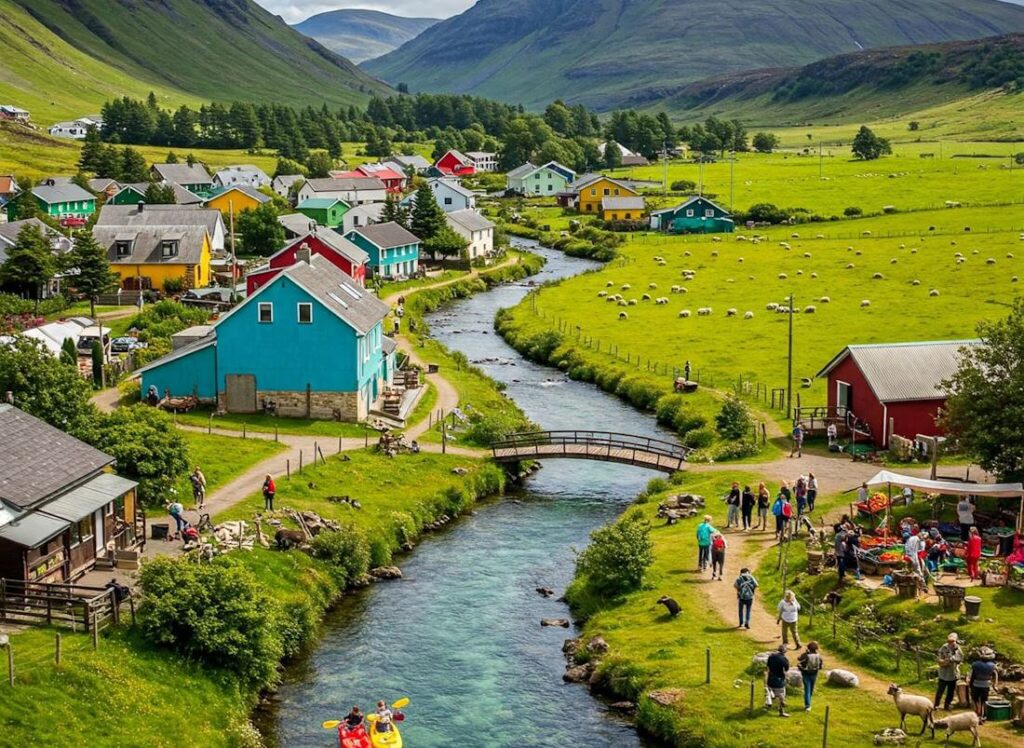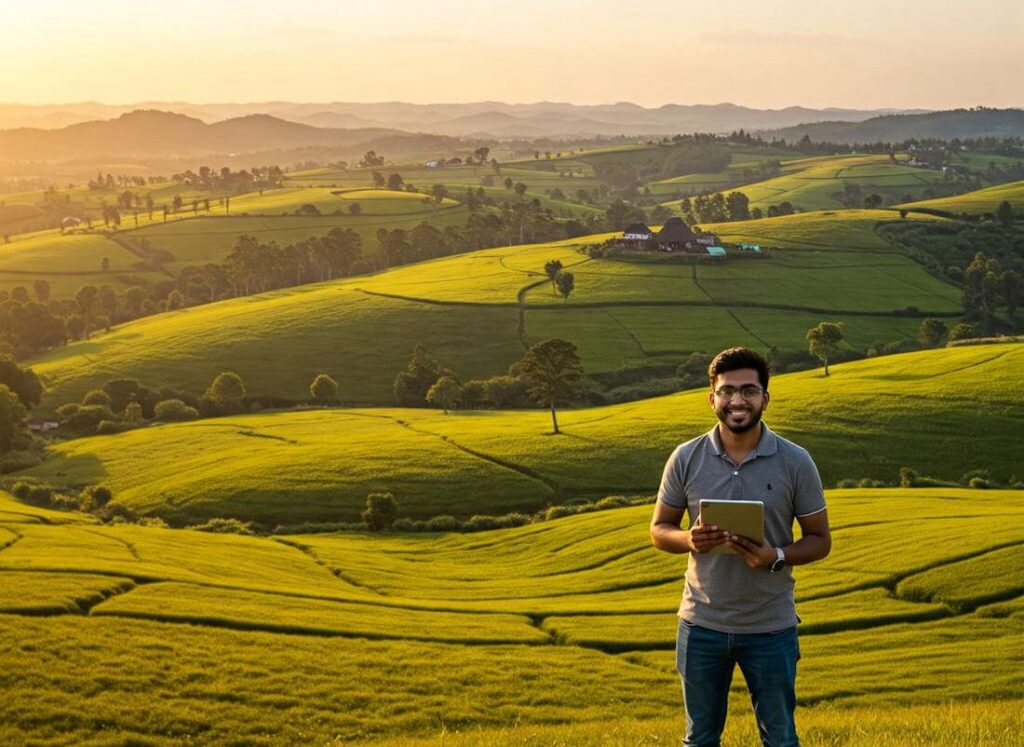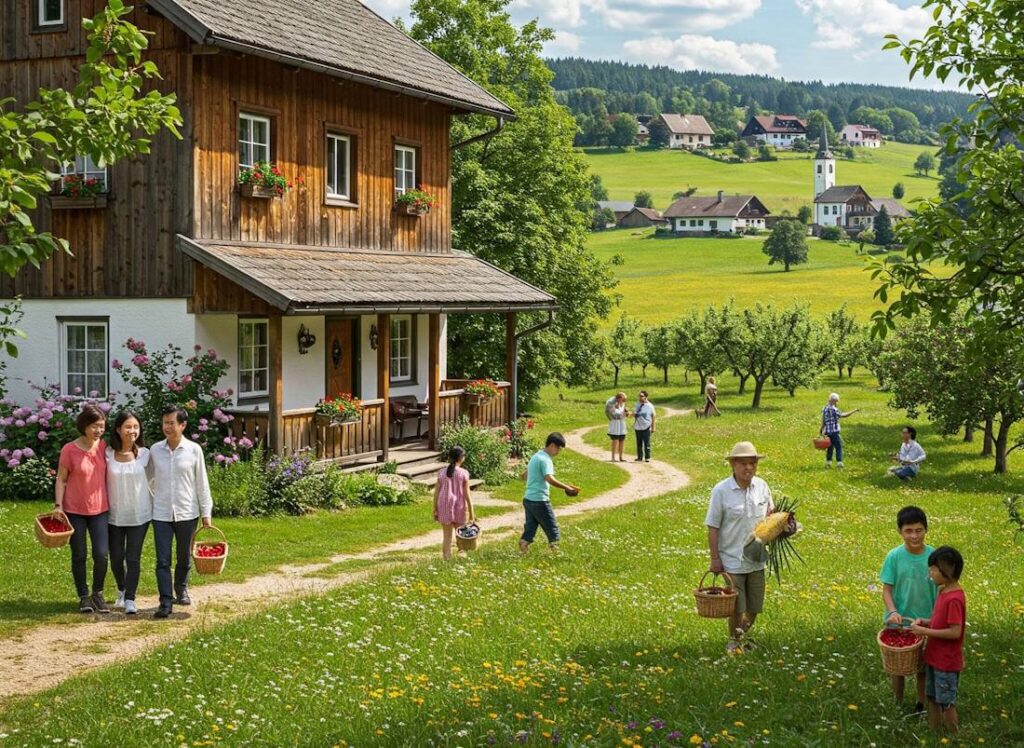Understanding the Importance of Tourism in Rural Areas
Tourism in rural areas plays a pivotal role in driving economic growth and promoting sustainability. As more individuals seek unique travel experiences, rural destinations have become increasingly attractive for their natural beauty, cultural heritage, and authentic community interactions. The economic implications of rural tourism are profound, as it can significantly contribute to job creation, bolster local businesses, and facilitate overall community well-being.
According to recent studies, rural tourism has experienced notable growth over the past decade, often outpacing urban tourism. Data indicates that rural destinations have witnessed a surge of visitors, resulting in increased demand for local services such as restaurants, accommodations, and recreational activities. This tourism influx not only fosters job creation in various sectors but also encourages entrepreneurship, as locals meet the needs of a diverse tourist demographic. Small businesses thrive when tourists visit, resulting in a vibrant local economy.
Moreover, rural tourism contributes to sustainable development by encouraging conservation and the preservation of local culture and heritage. It allows communities to showcase their unique attributes, from natural resources to traditional crafts. By promoting eco-friendly practices, rural areas can attract environmentally conscious travelers who seek sustainable experiences. Such practices not only protect the environment but also enhance the quality of life for residents.
Statistical evidence demonstrates that regions emphasizing rural tourism have seen not just economic benefits but also improved community cohesion and pride. Increased visitor numbers can lead to enhanced public services, infrastructure improvements, and investment in community facilities, resulting in a better quality of life for residents. Consequently, the integration of tourism into rural economies enhances overall resilience, making them less reliant on singular industries and fostering a broader economic base.
Identifying Unique Selling Points (USPs) of Your Rural Area
Attracting tourists to your rural area requires a comprehensive understanding of what makes your locale truly unique. These unique selling points (USPs) are the essential attributes that differentiate your area from others and can be leveraged to appeal to potential visitors. To effectively identify these USPs, consider performing a thorough inventory of the distinctive features offered by your community.
Cultural heritage is one prominent aspect that can draw tourists to rural areas. Many rural locations boast historical landmarks, traditional crafts, and local festivals that encapsulate the essence of the region’s past. By highlighting these cultural elements in promotional materials, such as brochures and social media posts, you can create a compelling narrative that invites tourists to experience the rich history of your area.
Natural beauty is another significant USP that rural areas can capitalize on. Scenic landscapes, national parks, and pristine waterways often serve as major attractions for eco-tourists and outdoor enthusiasts. By investing in photography and marketing campaigns that showcase the breathtaking vistas and wildlife of your area, you can effectively capture the attention of individuals seeking tranquil retreats or outdoor adventures.
Recreational activities tailored to the local environment also contribute to your area’s appeal. From hiking and fishing to agritourism and nature trails, promoting these offerings can entice tourists seeking immersive experiences. Organizing workshops or tours that allow visitors to engage with the land, such as farm-to-table dining experiences, can further enhance their connection to your rural area and encourage longer stays.
Finally, local traditions play an indispensable role in establishing a unique identity for your community. Whether it is traditional crafts, folk music, or culinary specialties, promoting these time-honored practices can attract tourists interested in authentic experiences. Highlighting events that celebrate these traditions not only preserves them but also elevates the area’s allure for potential visitors.
Developing Infrastructure and Amenities for Tourists
The success of rural tourism largely hinges on the effective development of infrastructure and amenities that meet the needs and expectations of visitors. A fundamental aspect involves enhancing the transportation networks, including roads and public transit options, to ensure easy accessibility to the area. Visitors are more likely to explore rural destinations with well-maintained, easily navigable roads that connect key attractions, accommodations, and amenities.
Accommodation plays a pivotal role in attracting tourists. Improving the quality and diversity of lodging options, such as hotels, guesthouses, and campgrounds, not only caters to various preferences but also ensures tourists can enjoy a comfortable stay. It is essential to establish these accommodations in close proximity to major attractions and activities to create a seamless experience for visitors. Furthermore, developing partnerships with local hospitality providers can enhance the quality of services and promote an inviting atmosphere for tourists.
Signage is another crucial element in tourist-friendly infrastructure. Clear, informative signs directing visitors to attractions, parking areas, and essential services contribute to a more navigable environment. Additionally, the placement of welcome signs at entry points can create a sense of arrival, which is significant in fostering a warm and inviting atmosphere. The use of local language, culture, and imagery in signage can further enhance the unique identity of the rural area.
Alongside these components, investing in essential tourist facilities such as restrooms, information centers, and recreational areas is vital. These facilities enhance the overall visitor experience and contribute to the area’s reputation as a desirable destination. By prioritizing infrastructure and amenities, rural areas can create a welcoming environment that encourages tourism, driving economic growth while preserving the region’s unique character.
Creating Engaging Marketing Strategies
To effectively attract tourists to rural areas, it is essential to implement a variety of engaging marketing strategies. A formidable online presence can be one of the most influential factors in drawing potential visitors. Social media platforms offer an accessible and interactive space where rural destinations can showcase their unique offerings. Regular posts, vibrant images, and captivating stories about local culture, attractions, and events can create a strong impression. Engagement through comments and shares further amplifies visibility, making social media an invaluable tool in tourist outreach.
Collaborating with travel influencers is another effective avenue. These influencers have established trust with their audiences and can provide authentic endorsements of rural experiences. Partnering with influencers who align with the destination’s values helps create compelling content that resonates with potential visitors. Influencers can craft personal narratives around their visits, showcasing hidden gems and authentic interactions that typical advertisements may not capture. This strategy not only increases exposure but also enhances credibility among prospective travelers.
Participation in tourism fairs and industry events is also beneficial for rural destinations. These fairs provide an excellent opportunity to network with travel professionals, engage with potential tourists, and promote local attractions. By enhancing direct interactions with attendees, rural areas can create memorable experiences that resonate long after the event concludes. Distributing high-quality promotional materials, such as brochures or digital content, can further evoke interest and inform travelers about what to expect.
In conclusion, a combination of a robust online strategy, collaborations with digital influencers, and active participation in tourism events can significantly enhance the appeal of rural areas and drive tourist interest. By weaving these elements together, rural destinations can establish a powerful marketing presence that effectively attracts visitors. Engaging promotional content is essential in painting a vivid picture of the experiences awaiting tourists.
Leveraging Local Events and Festivals
Organizing or promoting local events and festivals can significantly enhance the allure of a rural area, drawing in tourists and contributing to economic growth. These events not only showcase the unique cultural aspects of the region but also provide visitors with memorable experiences. By fostering community engagement and emphasizing local traditions, rural areas can establish a vibrant event calendar that attracts diverse audiences.
Successful examples of local events can be observed across various rural regions. A prime illustration is the annual apple festival in an upstate New York village, which features a blend of apple-related activities, live music, and local crafts. This event not only attracts thousands of visitors annually but also boosts local businesses, ranging from farmers to restaurants. Another notable example is the rural art fair that highlights local artists, encourages creative expression, and brings in patrons interested in purchasing handmade goods. Such festivals create an avenue for enhancing community pride and economic stimulation.
When planning local events, it is crucial to consider factors such as the target audience, market demands, and accessibility to the area. Collaborating with local businesses and organizations can enhance the event and foster a sense of community ownership. Effective marketing strategies, including the use of social media, local newspapers, and partnerships with tourism boards, can significantly increase visibility and attendance. Additionally, providing incentives such as early-bird tickets or family packages can further encourage participation.
Ultimately, leveraging local events and festivals as a strategic approach not only boosts tourism but also reinforces community identity. By consistently hosting well-organized and marketed events, rural areas can establish themselves as desirable tourist destinations, ensuring sustainable economic growth.
Establishing Partnerships with Local Businesses
Building partnerships with local businesses is a pivotal strategy for attracting tourists to rural areas. Collaboration with restaurants, artisans, and tour guides not only fosters an enhanced visitor experience but also generates substantial economic benefits for the community. By working in concert, local businesses can create comprehensive packages that offer tourists a unique blend of experiences, thereby increasing their likelihood of visiting the rural area.
For instance, a partnership between local restaurants and tour operators can lead to exclusive dining experiences that highlight regional cuisine. When tourists enjoy authentic meals prepared with locally sourced ingredients, they gain a deeper appreciation of the area’s culture and heritage. Such dining experiences can be complemented by guided tours that showcase local attractions. As a result, these partnerships not only attract tourists but also encourage them to stay longer and engage more fully with their surroundings.
Moreover, artisans, such as craftspeople and artists, can contribute to a vibrant cultural landscape that appeals to visitors. Collaborations that promote local art can lead to the creation of arts-and-crafts fairs, exhibitions, or workshops, providing tourists with hands-on learning opportunities. By cultivating these partnerships, rural destinations can position themselves as unique travel locations and provide tourists with memorable experiences that they can cherish and share.
Additionally, local businesses can work together to implement joint marketing strategies, pooling resources to create promotional campaigns that target specific tourist demographics. Leveraging social media or local events to showcase these offerings can increase exposure and widen the audience reach. An integrated approach ensures that visitors are aware of the diverse attractions available, further enhancing the overall tourist experience.
In summary, establishing partnerships with local businesses is essential for creating a cohesive and attractive tourist experience in rural areas. By collaborating, businesses can enhance their service offerings, thereby boosting revenue and fostering economic growth within the community.
Utilizing Technology and Online Platforms
In the modern era, technology is a vital component of any successful tourism strategy, particularly in rural areas striving to attract visitors. The integration of technology can enhance visibility and accessibility, significantly influencing potential tourists’ decisions. One of the most effective tools in promoting tourism is the use of online booking platforms. Websites such as Airbnb and Booking.com have revolutionized the way travelers find accommodations, allowing rural destinations to showcase their unique offerings to a global audience. By ensuring listings are optimized with high-quality images and engaging descriptions, local businesses can draw in more visitors.
In addition to booking platforms, travel blogs and social media channels serve as excellent avenues for promoting rural attractions. Engaging travel bloggers and influencers to experience and write about the local culture, cuisine, and activities can effectively reach new demographics. Additionally, the use of platforms like Instagram, Facebook, and TikTok allows for real-time interaction with potential tourists, creating a community around the destination. Regularly showcasing unique experiences, seasonal events, and testimonials on these platforms enhances visibility and builds anticipation among travelers.
Moreover, mobile applications can significantly streamline tourist experiences. Creating an app that provides information on local attractions, dining options, and events can improve the visitor experience, ensuring tourists have the necessary resources at their fingertips. Features such as offline access and GPS navigation can prove invaluable in rural settings, where connectivity may be limited. Institutions and local governments should embrace technology solutions that cater to travelers’ needs, such as virtual tours and interactive maps, further enriching their experience. Leveraging such technological advancements is critical for rural areas to not only attract tourists but also foster sustainable economic growth.
Promoting Sustainable Tourism Practices
In recent years, the significance of sustainability in tourism has gained considerable attention, particularly in rural areas where the natural environment plays a crucial role in attracting visitors. Promoting sustainable tourism practices not only helps preserve the local ecosystem but also enhances the overall experience for tourists. This commitment to sustainability can lead to positive economic growth and long-term benefits for the community. Therefore, it is essential to implement strategies that promote eco-friendly practices while encouraging responsible tourism.
One effective approach is to raise awareness among tourists about the importance of minimizing their ecological footprint during their stay. This can be achieved through informational materials and guides that highlight local flora and fauna, as well as the unique ecosystems present in the area. Encouraging visitors to engage in activities such as hiking, bird watching, or participating in conservation projects not only fosters a deeper connection to the environment but also supports local conservation efforts.
Local businesses play a vital role in establishing a sustainable tourism model. By promoting and offering eco-friendly accommodations and services, rural areas can attract environmentally conscious tourists. Small hotels or lodges that utilize renewable energy sources, source local food products, and implement waste reduction practices can serve as excellent examples of sustainable tourism. Furthermore, providing training for local businesses on green practices can also encourage a collective approach to sustainability.
Enhancing community involvement is crucial for ensuring the benefits of tourism do not come at the expense of the local environment. Engaging locals in decision-making processes and fostering partnerships between conservation organizations and tourism stakeholders can help safeguard natural resources while also promoting sustainable practices. By aligning tourism efforts with local conservation initiatives, rural areas can create a win-win situation where both the environment and the community thrive.
Measuring Success and Gathering Feedback
In the realm of attracting tourists to rural areas, evaluating the effectiveness of tourism strategies is crucial for sustained economic growth. One of the most effective methods to gauge success is through the implementation of visitor surveys. These surveys can be conducted online or in-person and can provide valuable insights into the visitors’ experiences, preferences, and expectations. By analyzing the collected data, tourism stakeholders can identify what aspects of their offerings resonate well with tourists and what areas require improvement.
Local economic impacts serve as another key indicator of tourism success. This can be measured by assessing changes in revenue for local businesses, hospitality services, and attractions after implementing tourism initiatives. Tracking metrics such as increased foot traffic, hotel occupancy rates, and restaurant patronage can give a clear picture of how tourism is influencing the economic fabric of the area. Establishing partnerships with local chambers of commerce or economic development organizations can aid in systematically collecting and analyzing this data over time.
Feedback mechanisms play a vital role in refining tourism strategies. Effective channels for receiving feedback can include social media platforms, dedicated email addresses, or comment boxes located at popular tourist spots. Engaging with visitors through these channels not only fosters a sense of community but also encourages visitors to share their thoughts and experiences. Moreover, revisiting and adapting strategies based on this feedback are essential for long-term engagement. By refining tourism offerings based on real-time data, rural areas can create tailored experiences that draw more visitors while ensuring that they return for future visits. This commitment to continual improvement directly contributes to sustained economic viability in the tourism sector.



